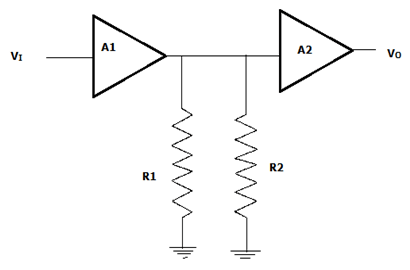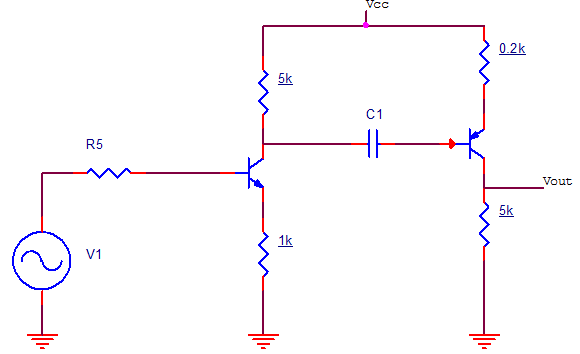1. Which of the statement is incorrect?
a) At unity gain frequency the CE short circuit current gain becomes 1
b) Unity gain frequency is the same as Gain Bandwidth Product of BJT
c) Gain of BJT decreases at higher frequencies due to junction capacitances
d) β- cut-off frequency is one where the CE short circuit current gain becomes β/2
Explanation: At unity gain frequency the current gain is 1 is a correct statement. The same frequency is fT = βfβ which is the gain bandwidth product of BJT. Gain of BJT at high frequency decreases due to the junction capacitance. However, at β cut-off frequency, current gain becomes \(\frac{β}{\sqrt{2}}\).
2. Given a MOSFET where gate to source capacitance is 300 pF and gate to drain capacitance is 500 pF. Calculate the gain bandwidth product if the transconductance is 30 mΩ-1.
a) 5.98 Mhz
b) 4.9 Mhz
c) 6.5Mhz
d) 5.22Mhz
Explanation: Gain bandwidth product for any MOSFET is fT = gm/2π(Cgs+Cgd)
Thus GBP is approximately 5.9 Mhz.
3. In an RC coupled CE amplifier, when the input frequency increases, which of these are incorrect?
a) Reactance CSH decreases
b) Voltage gain increases
c) Voltage gain decreases due to shunt capacitance
d) An RC coupled amplifier behaves like a low pass filter
Explanation:When frequency increases, shunt reactance decreases. The voltage drop across shunt capacitance decreases and net voltage gain decrease. RC coupled amplifier acts as a low pass filter at high frequencies.
4. For any cascaded amplifier network, which of these are incorrect?
a) Cascading increases gain
b) Overall input resistance is equal to the input resistance of the first amplifier
c) The overall output resistance is less than the lowest output resistance in all amplifiers used
d) Loading effect occurs
Explanation: In cascading, the output of one amplifier is connected to the input of another amplifier. It is used to increase gain while obtaining desired values of input and output resistances. Overall input resistance is the same as input resistance of the first amplifier and net output resistance is the same as output resistance of the last (nth) amplifier in the network. When amplifiers are connected in cascade, then loading effect does occur
5. Consider the circuit.
Loading effect occurs when ______________
a) R2 is small
b) A1 is small
c) R2 is large
d) A2 is large
Explanation: Loading effect refers to the effect of the input resistance of the nth amplifier in the net load resistance of the n-1th amplifier. The decrease of voltage gain of A1 above, due to smaller input resistance R2 of A2 is called loading effect. If the amplifier has larger input resistance, that is if R2 is large, no loading effect occurs. Such amplifiers are called non-interacting amplifiers
6. Consider the circuit shown.
Find internal voltage gain of the network given gm = 50mΩ-1 and β = 100.
a) 100
b) -90
c) 90
d) 95
Explanation: Both are CE amplifiers without a bypass capacitor.
For this, voltage gain is AV = -gmRL’/1+gmRE
A2 = -50 x 5/1 + 50 x 0.2 = -22.7
RL1 = 5k||RI2
RI2 = rπ + (1+β)RE = 100/50m + 101 x 0.2k = 2k + 20.2k = 22.2k
RL1 = 4.08kΩ
A1 = -50×4.08/1+ 50×1 = – 4
Gain = A’ = A1 x A2 = 90.8.
7. Cascading increases lower cut-off frequencies.
a) True
b) False
Explanation: Considering each amplifier has lower cut-off frequency fL1 then net lower cut-off frequency for a network of N cascaded amplifiers is fL = \(\frac{f_{L1}}{\sqrt{2^{1/N}}-1}\)
For N>=2, \(\sqrt{2^{1/N}}-1\) < 1, thus fL > fL1.
8. 6 similar amplifiers are cascaded, with lower cut-off frequency 100Hz. Bandwidth is B1=10 kHz. What is the higher cut-off frequency of the cascaded network?
a) 4000 Hz
b) 1667 Hz
c) 3642 Hz
d) 3000 Hz
Explanation: fL1 = 50 Hz
fL = 50/ \(\sqrt{2^{1/6}}-1\) = 142 Hz
B1 = 10kHz
B2 = B1 \(\sqrt{2^{1/N}}-1\) = 3.5 Khz
fH – fL = 3500
fH = 3642 Hz.
9.It is provided that the lower cut-off frequency of an individual amplifier is 25Hz, find the net cut-off frequency of a cascaded network of 8 similar amplifiers.
a) 200 Hz
b) 83 Hz
c) 100 Hz
d) 25 Hz
Explanation: fL1 = 25Hz
fL = \(\frac{f_{L1}}{\sqrt{2^{1/N}}-1} = \frac{25}{\sqrt{2^{1/8}} -1} = \frac{25}{\sqrt{0.0905}}\)
fL = 83 Hz.
10. Given that the higher cut-off frequency of the cascaded network of 6 amplifiers is 2Mhz, find the higher cut-off frequency of one amplifier, if all amplifiers are similar.
a) 5.7 Mhz
b) 0.33 Mhz
c) 12 Mhz
d) 64 Mhz
Explanation: fH = 2Mhz
fH = fH1 \(\sqrt{2^{1/N}}-1\)
fH1 = 2Mhz/√\(\sqrt{2^{1/6}}-1\) = 5.71 Mhz